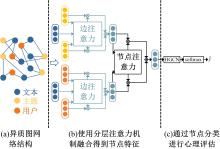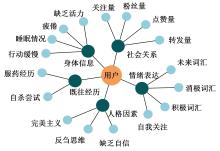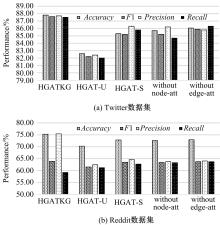Journal of Jilin University(Engineering and Technology Edition) ›› 2024, Vol. 54 ›› Issue (4): 1078-1085.doi: 10.13229/j.cnki.jdxbgxb.20220704
Psychological assessment method based on heterogeneous graph network
Zhi-gang JIN1( ),Ren-jun SU1,Xiao-fang ZHAO2
),Ren-jun SU1,Xiao-fang ZHAO2
- 1.School of Electrical and Information Engineering,Tianjin University,Tianjin 300072,China
2.School of Computer and Information Engineering,Tianjin Chengjian University,Tianjin 300384,China
CLC Number:
- TP183
| 1 | World Health Organization. World Mental Health Report: Transforming Mental Health for All[M]. Geneva: World Health Organization, 2022. |
| 2 | Coppersmith G, Dredze M, Harman C. Quantifying mental health signals in Twitter[C]∥Proceedings of the Workshop on Computational Linguistics and Clinical Psychology, Baltimore, USA, 2014: 51-60. |
| 3 | Shen G, Jia J, Nie L, et al. Depression detection via harvesting social media: A multimodal dictionary learning solution[C]∥Proceedings of the Twenty-Sixth International Joint Conference on Artificial Intelligence, Melbourne, Australia, 2017: 3838-3844. |
| 4 | Ive J, Gkotsis G, Dutta R, et al. Hierarchical neural model with attention mechanisms for the classification of social media text related to mental health[C]∥Proceedings of the Fifth Workshop on Computational Linguistics and Clinical Psychology: From Keyboard to Clinic, New Orleans, USA, 2018: 69-77. |
| 5 | Song X, Ming Z Y, Nie L, et al. Volunteerism tendency prediction via harvesting multiple social networks[J]. ACM Transactions on Information Systems, 2016, 34(2): 1-27. |
| 6 | 董飒, 刘大有, 李丽娜, 等. 基于类传播分布的关系近邻异质性网络分类方法[J]. 吉林大学学报: 工学版, 2016, 46(2): 522-527. |
| Dong Sa, Liu Da-you, Li Li-na, et al. Relational neighbor algorithm based on class propagation distributions for classification in networked data with heterophily[J]. Journal of Jilin University (Engineering and Technology Edition), 2016, 46(2): 522-527. | |
| 7 | Yang T, Hu L, Shi C, et al. HGAT: Heterogeneous graph attention networks for semi-supervised short text classification[J]. ACM Transactions on Information Systems, 2021, 39(3): 1-29. |
| 8 | Cao L, Zhang H, Feng L. Building and using personal knowledge graph to improve suicidal ideation detection on social media[J]. IEEE Transactions on Multimedia, 2022, 24: 87-102. |
| 9 | 黎才茂, 陈少凡, 林成蓉, 等. 基于知识图谱的多粒度社交网络用户画像构建方法[J]. 吉林大学学报: 工学版, 2022, 52(12): 2947-2953. |
| Li Cai-mao, Chen Shao-fan, Lin Cheng-rong, et al. Multi-grained social network user portrait construction method based on knowledge graph[J]. Journal of Jilin University (Engineering and Technology Edition), 2022, 52(12): 2947-2953. | |
| 10 | 王雨吟, 林锦婵, 潘俊豪. 个体认知-抑郁模型: 自我怜悯、完美主义、反刍思维和抑郁的关系[J]. 中国临床心理学杂志, 2015, 23(1): 120-123, 128. |
| Wang Yu-yin, Lin Jin-chan, Pan Jun-hao. The relationships among self-compassion perfectionism, rumination and depression[J]. Chinese Journal of Clinical Psychology, 2015, 23(1): 120-123, 128. | |
| 11 | Miller George A. WordNet: a lexical database for English[J]. Communications of the ACM, 1995, 38(11): 39-41. |
| 12 | Qi F, Yang C, Liu Z, et al. OpenHowNet: an open sememe-based lexical knowledge base[EB/OL]. [2022-08-19].. |
| 13 | Blei D M, Ng A Y, Jordan M I. Latent dirichlet allocation[J]. Journal of Machine Learning Research, 2003, 3: 993-1022. |
| 14 | Kayalvizhi S, Durairaj T, Chakravarthi B R,et al. Findings of the shared task on detecting signs of depression from social media[C]∥Proceedings of the Second Workshop on Language Technology for Equality, Diversity and Inclusion, Dublin, Ireland, 2022: 331-338. |
| 15 | Kayalvizhi S, Thenmozhi D. Data set creation and empirical analysis for detecting signs of depression from social media postings[EB/OL]. [2022-08-19]. . |
| 16 | Song X, Nie L, Zhang L, et al. Multiple social network learning and its application in volunteerism tendency prediction[C]∥Proceedings of the 38th International ACM SIGIR Conference on Research and Development in Information Retrieval, Santiago, Chile, 2015: 213-222. |
| 17 | Rolet A, Cuturi M, Peyré G. Fast dictionary learning with a smoothed wasserstein loss[C]∥Proceedings of the 19th International Conference on Artificial Intelligence and Statistics, Cadiz, Spain, 2016: 630-638. |
| 18 | Pedregosa F, Varoquaux G, Gramfort A, et al. Scikit-learn: Machine learning in Python[J]. Journal of Machine Learning Research, 2011, 12: 2825-2830. |
| 19 | Gui T, Zhu L, Zhang Q, et al. Cooperative multimodal approach to depression detection in Twitter[C]∥ Proceedings of the Thirty-Third AAAI Conference on Artificial Intelligence and Thirty-First Innovative Applications of Artificial Intelligence Conference and Ninth AAAI Symposium on Educational Advances in Artificial Intelligence, Honolulu, USA, 2019: 110-117. |
| 20 | Devlin J, Chang M W, Lee K, et al. BERT: Pre-training of deep bidirectional transformers for language understanding[C]∥Proceedings of the 2019 Conference of the North American Chapter of the Association for Computational Linguistics, Minneapolis, Minnesota, 2019: 4171-4186. |
| 21 | Liu Y, Ott M, Goyal N, et al. RoBERTa: A robustly optimized BERT pretraining approach[EB/OL]. [2022-08-19]. . |
| 22 | Nam H, Ha J W, Kim J. Dual attention networks for multimodal reasoning and matching[C]∥Proceedings of the IEEE Conference on Computer Vision and Pattern Recognition, Honolulu, USA, 2017: 299-307. |
| 23 | Moon S, Neves L, Carvalho V. Multimodal named entity disambiguation for noisy social media posts[C]∥Proceedings of the 56th Annual Meeting of the Association for Computational Linguistics, Melbourne, Australia, 2018: 2000-2008. |
| 24 | Poświata R, Perełkiewicz M. OPI@ LT-EDI-ACL2022: Detecting signs of depression from social media text using RoBERTa pre-trained language models[C]∥Proceedings of the Second Workshop on Language Technology for Equality, Diversity and Inclusion, Dublin, Ireland, 2022: 276-282. |
| [1] | Jing-peng GAO,Guo-xuan WANG,Lu GAO. LSTM⁃MADDPG multi⁃agent cooperative decision algorithm based on asynchronous collaborative update [J]. Journal of Jilin University(Engineering and Technology Edition), 2024, 54(3): 797-806. |
| [2] | Wen-ming JIANG,Li-zhong QI,Su ZHANG,Jing-guo RONG,Hong-bo WU,Chao ZUO,Xiao-long ZHANG. Quality inspection method of electric power engineering building information model based on knowledge graph [J]. Journal of Jilin University(Engineering and Technology Edition), 2024, 54(3): 807-814. |
| [3] | Liu LIU,Kun DING,Shan-shan LIU,Ming LIU. Event detection method as machine reading comprehension [J]. Journal of Jilin University(Engineering and Technology Edition), 2024, 54(2): 533-539. |
| [4] | Jian LI,Qi XIONG,Ya-ting HU,Kong-yu LIU. Chinese named entity recognition method based on Transformer and hidden Markov model [J]. Journal of Jilin University(Engineering and Technology Edition), 2023, 53(5): 1427-1434. |
| [5] | Chun-hui LIU,Si-chang WANG,Ce ZHENG,Xiu-lian CHEN,Chun-lei HAO. Obstacle avoidance planning algorithm for indoor navigation robot based on deep learning [J]. Journal of Jilin University(Engineering and Technology Edition), 2023, 53(12): 3558-3564. |
| [6] | Tian BAI,Ming-wei XU,Si-ming LIU,Ji-an ZHANG,Zhe WANG. Dispute focus identification of pleading text based on deep neural network [J]. Journal of Jilin University(Engineering and Technology Edition), 2022, 52(8): 1872-1880. |
| [7] | Sheng-sheng WANG,Lin-yan JIANG,Yong-bo YANG. Transfer learning of medical image segmentation based on optimal transport feature selection [J]. Journal of Jilin University(Engineering and Technology Edition), 2022, 52(7): 1626-1638. |
| [8] | Wen-jun WANG,Yin-feng YU. Automatic completion algorithm for missing links in nowledge graph considering data sparsity [J]. Journal of Jilin University(Engineering and Technology Edition), 2022, 52(6): 1428-1433. |
| [9] | Hao-yu TIAN,Xin MA,Yi-bin LI. Skeleton-based abnormal gait recognition: a survey [J]. Journal of Jilin University(Engineering and Technology Edition), 2022, 52(4): 725-737. |
| [10] | Yong LIU,Lei XU,Chu-han ZHANG. Deep reinforcement learning model for text games [J]. Journal of Jilin University(Engineering and Technology Edition), 2022, 52(3): 666-674. |
| [11] | Cai-mao LI,Shao-fan CHEN,Cheng-rong LIN,Hao LIN,Qiu-hong CHEN. Multi⁃grained social network user portrait construction method based on knowledge graph [J]. Journal of Jilin University(Engineering and Technology Edition), 2022, 52(12): 2947-2953. |
| [12] | Jing-pei LEI,Dan-tong OUYANG,Li-ming ZHANG. Relation domain and range completion method based on knowledge graph embedding [J]. Journal of Jilin University(Engineering and Technology Edition), 2022, 52(1): 154-161. |
| [13] | Zhi-hua LI,Ye-chao ZHANG,Guo-hua ZHAN. Realtime mosaic and visualization of 3D underwater acoustic seabed topography [J]. Journal of Jilin University(Engineering and Technology Edition), 2022, 52(1): 180-186. |
| [14] | Yan-lei XU,Run HE,Yu-ting ZHAI,Bin ZHAO,Chen-xiao LI. Weed identification method based on deep transfer learning in field natural environment [J]. Journal of Jilin University(Engineering and Technology Edition), 2021, 51(6): 2304-2312. |
| [15] | Yong YANG,Qiang CHEN,Fu-heng QU,Jun-jie LIU,Lei ZHANG. SP⁃k⁃means-+ algorithm based on simulated partition [J]. Journal of Jilin University(Engineering and Technology Edition), 2021, 51(5): 1808-1816. |
|
||





